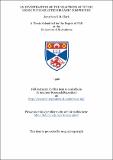An investigation of the reactions of nitric oxide with selected organic compounds
Abstract
The reaction of nitric oxide (NO) with several organic and model biological compounds was studied to determine the ultimate fate of NO in a biological milieu, and to devise novel methods of trapping and analysing NO. A series of potential spin traps including anthracene, o-quinone and 2- acetylcyclohexanone was investigated by bubbling NO through a solution of the above compounds. The resulting mixture was analysed by EPR spectroscopy and GC-MS. The EPR spectra obtained showed no radicals were produced and GC-MS analysis revealed only unreacted starting material. Dienes were investigated because of their willingness to react with radical species. Trans-1,4-diphenyl-1,3-butadiene did not form a nitroxide when reacted with NO, but in the presence of molecular oxygen, 2,5-dimethyl-2,4-hexadiene gave a mixture of a di-t-alkyl nitroxide and a t-s-dialkyl nitroxide. Traps related to nitromethane anion were investigated in basic solution to generate the aci form, but the only compound to give a spin adduct was nitroethane, and this did not give the expected EPR spectrum. 2-Diazocycloheptanone was synthesised from cycloheptanone and reacted with NO. This reaction produced E and Z iminoxyl radicals and a carbonyl nitroxide. When the solvent was changed from t-butyl benzene to water, no reaction was observed. A known NO donor, S-nitroso-N-acetyl penicillamine (SNAP), was mixed with the spin trap and photolysed, but this did not produce a spin adduct. A second diazo compound, 5-diazouracil, was investigated, and this produced a radical species with complex but weak EPR spectra. Nitric oxide was reacted with stable free radicals to provide a quantitative spectrophotometric test for NO. Tetraphenylhydrazine was prepared which is in equilibrium with the diphenylaminyl radical in solution. The diphenylaminyl radical trapped NO and was detected by UV/vis spectroscopy, reaching a λ[sub]max after about one hour. When the solvent was changed from t-butyl benzene to acetonitrile, the reaction took place much more rapidly. From these results it appeared that NO could be detected at concentrations beteween 10 ⁻⁴ and 10⁻⁷ M. Nitric oxide did not react with the parent compound, diphenylamine. When mixed with NO2, diphenylamine formed nitro addition products. Another stable radical, galvinoxyl, was investigated. This did not rapidly scavenge NO to give an identifiable adduct. Nitric oxide was reacted with several alkenes with electron-releasing groups and alkenes with electron-withdrawing groups. The reaction between n-butylvinyl ether and NO was investigated at room temperature. Many oxidation products were identified from the mass spectra obtained. Oxidation products were also identified from the reaction between NO and 1-cyclohexenyIoxytrimethylsilane. Analysis by EPR spectroscopy revealed the presence of two radicals, likely to be dialkyl nitroxides. No products were observed in the reaction of NO and methyl linoleate. EPR spectroscopy of a solution containing mesityl oxide and NO revealed the presence of three radicals, E and Z conformers of the iminoxyl radical, and a carbonyl nitroxide. 1-Acetylcyclohexene reacted with NO to give a di-t-alkyl nitroxide. Synthesis and subsequent photolysis of 1-acetylcyclohexenyl oxime confirmed this result. Another acceptor compound studied was tetracyanoethene; this did not react with NO. Cyclopropylacetyl peroxide was investigated, as decomposition gives the cyclopropyl methyl radical. Analysis of the resulting solution showed that bicyclohexyl had been formed, but there were no traces of any nitrogen-containing products. Nitric oxide did not react with either glutathione or dibenzyl disulphide, but NO2 reacted with L-tryptophan forming a radical adduct. Analysis by EPR spectroscopy yielded a strong three-line signal, characteristic of a nitroxide. The abstraction of hydrogen from, and the rearrangement of selected silylamines was investigated. The amines were photolysed in the presence of di-t-butyl peroxide in the cavity of the EPR spectrometer at temperatures ranging from 160K to 250K. The spectra obtained showed the unrearranged and rearranged radicals. No nitrogen-centred radicals were observed by EPR.
Type
Thesis, PhD Doctor of Philosophy
Collections
Items in the St Andrews Research Repository are protected by copyright, with all rights reserved, unless otherwise indicated.

